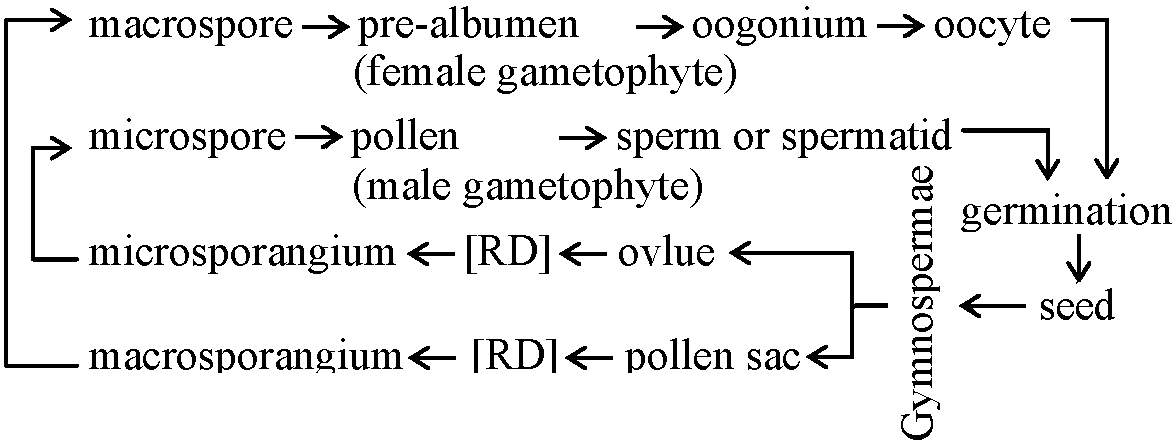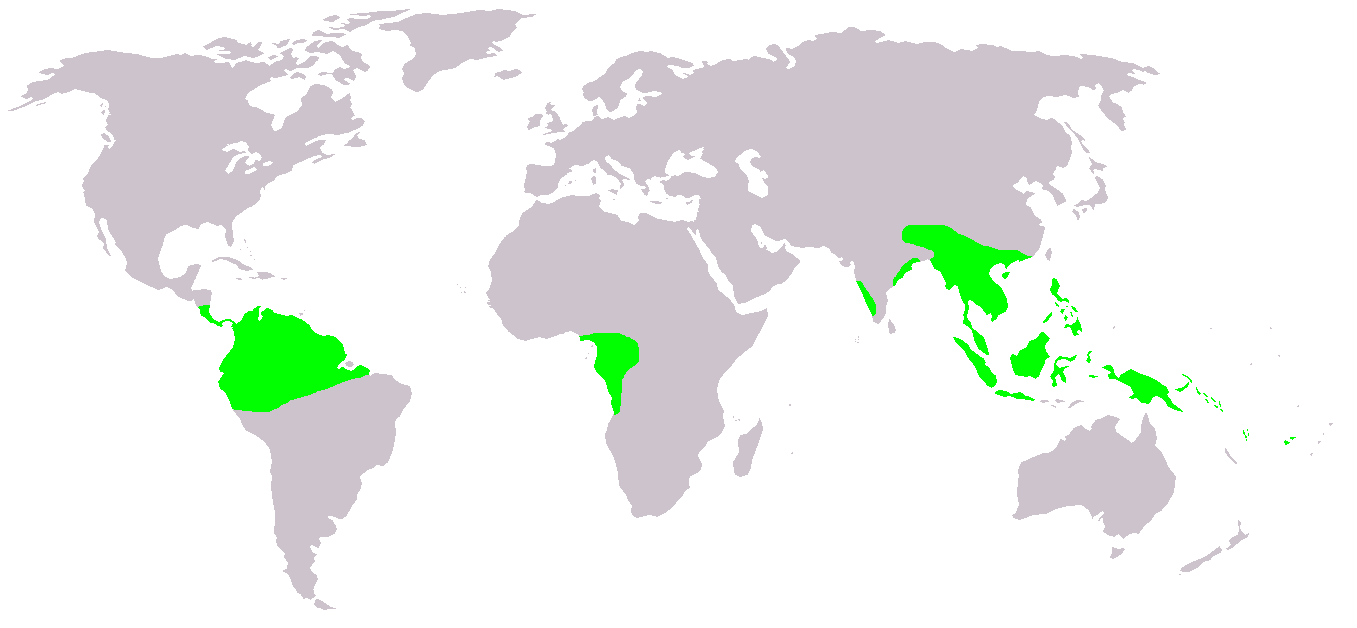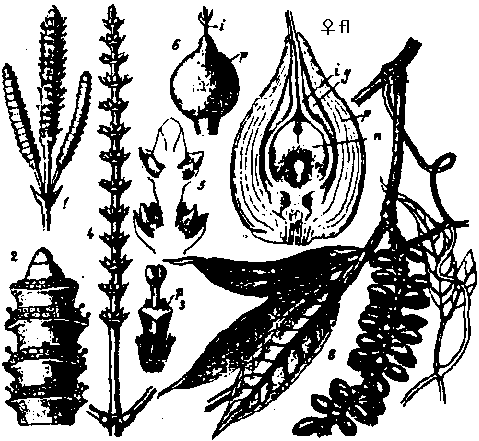(Upload on March 18 2018) [ 日本語 | English ]
Mount Usu / Sarobetsu post-mined peatland
From left: Crater basin in 1986 and 2006. Cottongrass / Daylily
HOME > Plant taxonomy (植物分類学) > Plant list (植物リスト) > Gymnospermae
|
[Engler's syllabus (エングラー体系), Angiospermae (被子植物)] Gymnospermae (Gr. gymnos = naked + Gr. sperma = seed) and the informal term "gymnosperm" General characteristicsvegetable organ = vegetative type (or sporophyte) → remarkable, asexualvegetable organ = gametophyte → degenerative, parasitical, sexual
♀ |
Life cycle
|
| Cycadopsida | Coniferopsida | |
| Leaf | Large, complex, fern-frond-like compound | Simple, often scale-like or needle-like |
| Leaf trace | Numerous | One to a few, simple |
| Leaf base | Persistent, forming an "armor" on the stem | Not persistent |
| Stem | Not differentiated into long and spur shoots | Having long and spur shoots |
| Wood | Pith and cortex extension, as compared with xylem and phloem. Xylem loosely arranged with broad parenchymatous rays (monoxylix) | Pith and cortex restricted, xylem composing bulk of stem. Xylem compact, composed mostly of tracheids, rays narrow (pycnoxylic) |
| Ovule (+ seed) | Ovlues borne singly on leaves, in simple strobili, on a megasporophyll (Cycas), or on an conical axis. Seed is radical symmetry. | Ovlues often borne in compound strobili or ovlues borne singly. Seed is bilateral symmetry |
|
1869 Hrase S (平瀬作五郎): discovered sperms from Ginkgo biloba 1869 Ikeno S (池野成一郎): discovered sperms from Cycas revoluta → kinship with Pteridophyta ↓ Potonie (Cycadofilices ソテツシダ類): capsule (杯状体)_sulpynx↓ Mudullose: capsule – fusion with integument__________↓ Cycas: basicall same with Mudullose_________________shrinkage Subclass Pteridospermidae (シダ状種子植物*)Devonian- JurassicSubclass Cycadidae (ソテツ)Cycas and confiers – development of microspore
microspore → prothalial cell | | → stalk cell | → body cell → sperm (♀) free nuclear division → archegonium = same with Ginkgo The maturation of seeds needs longer time Ex. June ♀ macrospore cell → pollination / miosis: tissues developed one year later → fertilization in the next year Order Bennettitales *: TriassicOrder Cycadales (ソテツ): Upper Triassic-present Cycadaceae Pers. (ソテツ) Leaf emergence: curly in the early stage like Osmunda japonica Identification by vegetative organs is difficult Microscopic structures of organs are about the same with those of Ginkyo The development of secondary xylem is not well Cycas L. (one genus) C. circinalis L. (インドソテツ) C. revoluta Thunb. (ソテツ) C. rumphii Miq. (ナンヨウソテツ) C. taitungensis C. F. Shen, K. D. Hill, C. H. Tsou et C. J. Chen (タイワンソテツ) |
 Fig. Cycas and its allies. inside of seed: cotyledone that has already formed, enclosed by endosperm (内胚乳). endosperm = haploid. Cross section: p = pith, v = vascular bundle, lt = leaf trace Zamiaceae Horan. (ザミア), sago-cycas family when separated from Cycadaceae Subfam Encephalartoideae Tribe Diooeae: Dioon Lindl. (サゴソテツ) Tribe Encephalarteae: Encephalartos Lehm.,Macrozamia Miq., Lepidozamia Lehm. Subfam Zamioideae Tribe Ceratozamieae: Ceratozamia Brongn. (ツノザミア) Tribe Zamieae: Microcycas (Miq.) A. DC. (オニソテツ), Chigua D. W. Stev., Zamia L. (フロリダソテツ) Also Bowenia is classified into Zamiaceae (see Cycadaceae) Nilssoniaceae*Subclass Pentoxylidae*One family and one orderOrder Pentoxylales Pentoxylaceae → phylogenetical reation is unknown, probably shrub Subclass GinkgopsidaOrder GinkgoalesTrichopityaceae * Lower Permian in France Ginkgoaceae (イチョウ) = Ginkgo biloba, monotypic in the present Fossil: ≥ 17 species → diverse (after Upper Paleozoic)
(♂) p.c. = prothalial cell | pollen (n) | | → stalk cell | → body cell → sperm (♀) free nuclear division → archegonium |
*: extinct (fossil records)
|
Evolution of flower → one scale = one flower → The whole of pine cone = inflorescence Species non-producing cones in Coniferopsida
1. devolution → 1 seed (e.g., Podocarpus)
→ Taxopsida (establishing independent version of class) × Podocarpaceae forming epimatium → different phylogeny Order Cordaitales*upper Devonian - the Permian* (flourished in the Carboniferous) |
Order Coniferales (球果植物目) = Pinales (マツ目)Walchiaceae (Lebachiaceae)*Voltziaceae* Palissyaceae* Araucariaceae (ナンヨウスギ) Sciadopityaceae Pinaceae (マツ, conifer) Cupressaceae (ヒノキ): Actinostrobus Miq. (WA) Order Taxales (= Class Taxopsida) (イチイ)Podocarpaceae マキCephalotaxaceae イヌガヤ Taxaceae イチイ |
GrowthLeaf = finite or determinate growth (exception: Lygodium japonicum, Diplopterygium glaucum – growth point on apex)Stem = indeterminate growth (exception: Welwitschia – growth point on leaf base) Vessel present + xylem fiber present Companion cell developed in a few species (Gnetum) → close to Angiospermae Lignin structure close to Angiospermae Ovule (♀): enveloped by a structure like a perianth or floral envelope s.s., connate scales) Microsporangium (♂): the number of microsporangia present in an androphore or a microsporangiophore are constant on each species female flower connoted vestigial or immature ♂ – Welwitschia, Gentum Order Ephedrales (= Ephedraceae)(♂) The microsporangiate strobili have rounded apices, while those of the ovulate strobilis are acute. The strobili of E. antisyphilitica are already visible and well developed in the vicinity of abilene and elsewhere in texas, at the nodes among the fasciculate, photosynthetic axis (Bold et al. 1980).Microspore
→ prothalial cell
│ → pollen (n): 4 cells = spores Order Welwitschiales (= Welwitschiaceae サバクオモト)often merged into GnetalesMicrospore
→ prothalial cell
│ → pollen (n): three cells = spores Pollen formation of Welwitchia is earlier than that of Gnetum because the karyokinesis makes a time  |
Fig. Disjunct distribution area of Welwitschia and its relation to annual rainfall. (a) is a satellite map of southwestern Africa from 12.5&de; to 24°S latitude. The black dots represent 991 Welwitschia locations confirmed by or newly recorded during this project. Large populations with a quasi-continuous presence are shown in gray. Isolated range fragments are named in yellow. White numbers and names designate the locations of populations sampled for SSR analysis. The isolation of range fragments is indicated by their distance in km. The white bar designates a major geographic gene-flow barrier; within Welwitschia, the broken lines designate geographic gene-flow barriers within subspecies. The black line marks the border between Angola and Namibia. (b) shows Welwitschia locations and range fragments (as in a) against a color ramp, which illustrates the arid zone in yellow, orange, and red. The blue lines are isohyets of mean annual rainfall in 100-mm increments. The horizontal black line marks the border between Angola and Namibia. (Jürgens et al. 2021)
Welwitschia Hook. f. = W. mirabilis Hook. f.
Synonyms: Tumboa bainesii Hook. f., Welwitschia bainesii (Hook. f.) Carrière, nom. inval., Tumboa strobilifera Welw. ex Hook. f. ssp. mirabilis, male flower = red brownssp. namibiana Leuenb., male flower = grey brown Order Gnetales (= Gnetaceae)ca. 50 spp. Gnetum L. (G. gnemon, the type) Fig. Distribution of genus Gnetum  Fig. Gnetum gnemon L., Gnemon tree ♀ flower = female gametophyte = the structure is clearly Gymnospermae (archaegonium, not developed) |